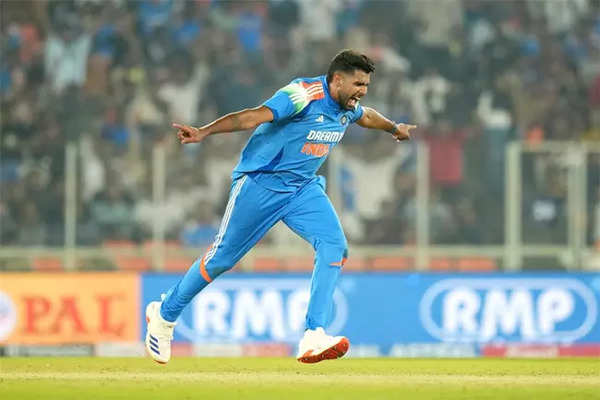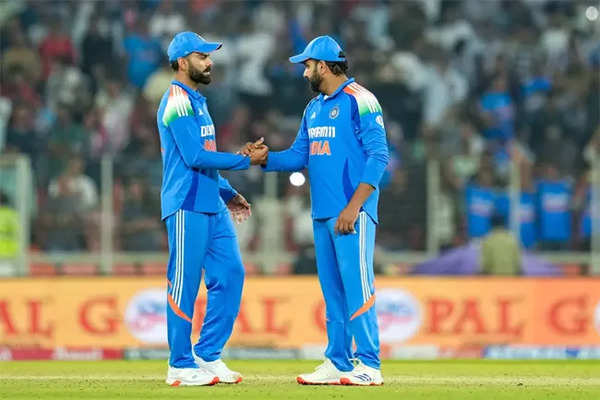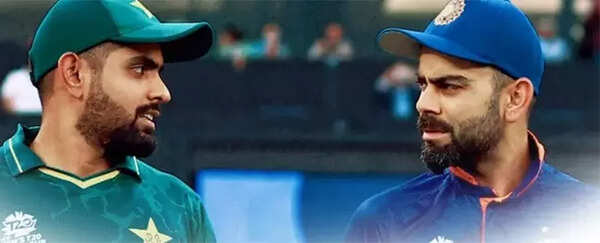NEW DELHI: When India face Pakistan, everything is at stake. The world seems to come to a standstill, streets fall silent, and homes erupt with deafening cheers or pin-drop silence – depending on which side of the border you reside in. A sea of blue will flood the stands when the ‘mother-of-all-clashes’ unfolds on Sunday (February 23) with Rohit Sharma and Mohammad Rizwan stepping up for the toss at the Dubai International Stadium.
India are placed in Group A alongside Bangladesh, Pakistan, and New Zealand. They will begin their campaign in Dubai on February 20 against Bangladesh, followed by the much-anticipated showdown against Pakistan on February 23, before taking on New Zealand on March 2.
The last time these two fierce rivals met was in the 2024 T20 World Cup in New York, where India clinched a thrilling six-run victory in a low-scoring encounter.
In an exclusive interview with TimesofIndia.com, former Pakistan speedster Abdur Rauf Khan shared his insights on the upcoming blockbuster clash, Jasprit Bumrah’s absence, rising star Harshit Rana, the Virat Kohli vs Babar Azam debate, and much more…
Does Jasprit Bumrah’s absence significantly impact India’s chances?
Absolutely. If Bumrah was playing, I would confidently say India would win. He’s currently the best fast bowler in the world, excelling across all formats—ODIs, Tests, and T20s. In my opinion, he’s the most complete bowler in the game right now. India have relied heavily on Bumrah over the past two years, and unfortunately, they don’t have a like-for-like replacement. Siraj performed well in the last Asia Cup and World Cup, but he has been out of form for the past six months. Without Bumrah, India’s pace attack lacks a leader, and it will be challenging for a newcomer to step in and handle the pressure against top teams like Pakistan, Australia, England, and New Zealand. His absence will be a huge loss for India.
Do you think Harshit Rana is a good selection over Mohammad Siraj?
I think India should have stuck with Siraj. They seem to be making a similar mistake to what Pakistan did by dropping Abdullah Shafique, who had performed exceptionally well in the last World Cup. Siraj has been a top performer for India in major tournaments over the past few years. Replacing him with an inexperienced bowler just before a big event is risky. New bowlers take time to adjust, especially in challenging conditions like Pakistan, Dubai, and Sharjah. Handling the pressure in such crucial matches is not easy. I believe India should have backed Siraj alongside Shami. But it’s up to the selectors—let’s see how the new player performs.

With Jasprit Bumrah absent, a lot of responsibility will be on Mohammad Shami’s shoulders …
Shami is India’s most experienced fast bowler now, and I believe he can handle the pressure well. He has been playing first-class cricket consistently, which helps maintain rhythm and fitness. You can always judge a player’s form from their first-class performances, and Shami has proven himself time and again. He was exceptional in the last World Cup and other major tournaments. While replacing Bumrah is nearly impossible, I think Shami will step up and lead the attack effectively.
Which two key players from India and Pakistan do you think can change the game?
For India, I would pick Hardik Pandya and Rohit Sharma. Pandya is a match-winner who can turn the game around with both bat and ball, while Rohit’s experience in high-pressure games is invaluable. For Pakistan, Mohammad Rizwan is always a threat against India—he has a great record in these encounters. The other key player, in my opinion, is Naseem Shah. He has been Pakistan’s most consistent bowler lately, with great control over his line and length.
You didn’t mention Shaheen Shah Afridi. What about his battle against Virat Kohli?
A couple of years ago, I would have definitely included Shaheen Shah Afridi. At his peak, he was one of the best fast bowlers, regularly clocking 145+ kmph and swinging the ball beautifully. But after his knee injury, he has lost pace—now bowling around 134-135 kmph—and isn’t swinging the ball as effectively. His bowling action has also changed post-injury, affecting his ability to take early wickets with the new ball. His strength was always his ability to move the ball in the air, which troubled top-order batsmen [batters] like Rohit Sharma. At the moment, though, he seems to be struggling, and I feel Naseem Shah is the more dangerous bowler for Pakistan.

India chose not to travel to Pakistan for the Champions Trophy. What’s your take on that?
I think India should have traveled to Pakistan, just like all the other teams. Pakistan is the official host, and when India hosted the World Cup, Pakistan played all their matches in India. It would have been a great opportunity for Pakistani fans to watch Indian stars play live. But unfortunately, political issues have kept India from touring. Regardless, Pakistan will still travel to play against India whenever required, and Pakistani fans will miss watching this great rivalry unfold on their home soil.
Who are your four semifinalists for the Champions Trophy?
My favourite team is New Zealand. They have great team balance, strong momentum, and well-defined roles for each player. India are another strong contender. South Africa have been playing excellent cricket and could go far. As for the fourth team, Pakistan have a chance—especially if they win their opening match against New Zealand.
Who do you think is the title favourite?
New Zealand is my top pick. They are a well-balanced, experienced side with a strong batting lineup, quality bowlers, and good spinners. More importantly, they have a clear understanding of their game plans, which gives them an edge over other teams.
How do you define the India-Pakistan rivalry? Some say it’s bigger than the Ashes.
It’s an electrifying contest—arguably the biggest game in world cricket. This rivalry goes beyond just cricket; the entire world tunes in. The pressure and intensity of an India-Pakistan match are unmatched. This time, both teams seem evenly matched. If Bumrah were playing, I would have given India a clear advantage, but with his absence, the contest looks much closer. It’s going to be an exciting battle.

Babar Azam is often compared to Virat Kohli. What’s your take on this debate?
Both are great players, but in my opinion, Virat Kohli has no comparison. His class, consistency, and ability to perform under pressure set him apart. Babar Azam, when in form, is exceptional. But personally, my favourite batsman [batter] is Rohit Sharma. I believe Rohit is currently the best batsman [batter] in world cricket. He is way better than Virat and Babar.
What’s your prediction for the high-octane India vs Pakistan clash?
You can never predict the outcome of an India vs Pakistan match. It’s always a high-pressure game, and it’s not just India and Pakistan — fans from all over the world are invested in this contest. Both teams are strong, so making a prediction is difficult. A month ago, if you had asked me, I would have confidently said that India had the upper hand with Bumrah in the squad. But now, with his absence, it’s much harder to call. He was instrumental in India’s victories in the last Asia Cup and World Cup. At this moment, I believe the teams are evenly matched.
The key difference for India lies in experienced players like Rohit Sharma and Virat Kohli, who have played numerous India-Pakistan encounters and know how to handle the pressure. On the Pakistan side, Babar Azam and Mohammad Rizwan are the senior players to watch. However, Babar hasn’t been at his best over the past year, which puts additional pressure on Pakistan. Considering the conditions in Dubai, I would still say India has a slight edge over Pakistan.
